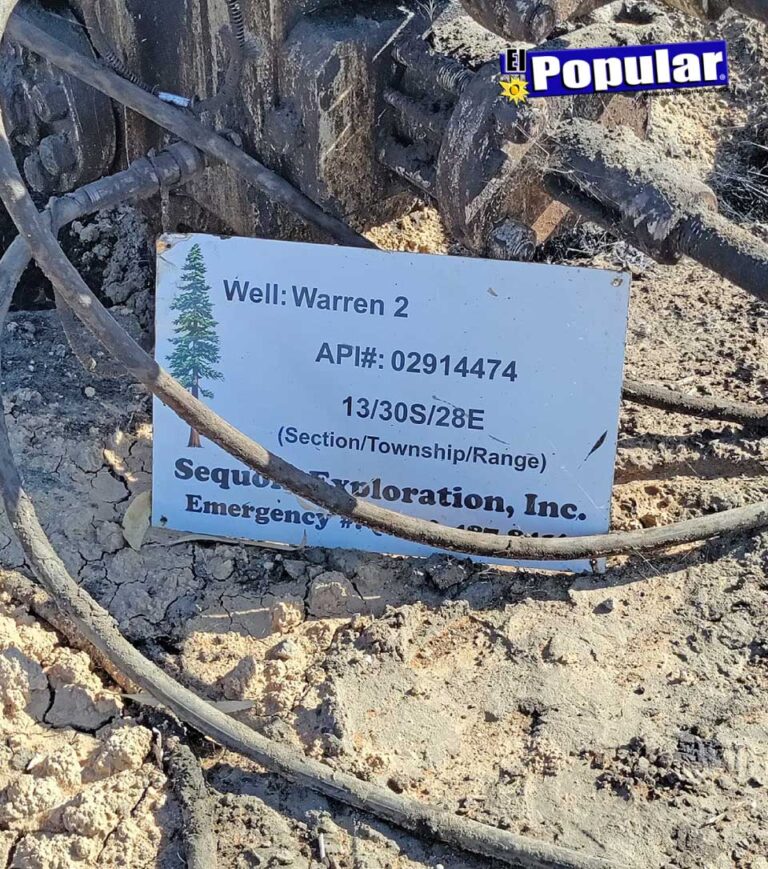Inactive wells can release gasses and pollution that can cause cancer and other diseases.
BAKERSFIELD, CA – A new report by the Sierra Club organization has found that oil companies have created and subsidized a crisis of inactive oil wells throughout California that has harmed Kern County for decades. The report discloses new local information about who exactly owns these wells and the cost of cleaning them up. It details how the cleanup process would create new jobs and improve public health.
The Sierra Club report found that two-thirds (2/3) of the inactive oil wells throughout California are owned by three companies: Chevron, Aera Energy (previously owned by Shell and Exxon) and California Resources Corporation (CRC). In total, there are 41,568 inactive or uncovered wells in California, most of them concentrated in towns where the majority of the population is Latino (Kern, Los Angeles, Ventura, Fresno and Santa Barbara Counties).
These wells, referred to as orphaned wells, are known to leak dangerously high levels of the carcinogen benzene, which makes this a health and safety crisis for the community and poses the great danger of contaminating groundwater wells.
In the community of Lamont, organic farmer Larry Saldaña had problems with a well located on his property. Although the well was inactive, the well was splashing crude oil which was contaminating his animals, greenhouses and farm water. The company responsible for the well, Bakersfield-based Sequoia Exploration Inc. refused to take responsibility. Saldaña requested that the company replace the affected land on his small two-and-a-half acre farm and replace the fruit trees with mature trees.
Sequoia, instead, offered to clean oil from structures on the property, replace a greenhouse roof and test the soil for regulatory contamination levels for a total of $50,000 plus $2,000 for Saldaña. However, Saldaña claimed that the cleanup of his property could exceed $1 million and that he would need to change the use of a property in which he had invested $50,000 in vegetable and nutrient soil.
Since Saldaña has refused to sign, this has put Sequoia in hot waters with regulators who have intervened in the past. If Saldaña does not sign, Sequoia could face local and state fines.
The report states that Kern County is home to more than 28,417 orphaned or inactive wells, which represents 68 percent of all wells in California.
State law allows wells to remain inactive for years, often decades, and more than one-third of wells in the state have been inactive for eight years or more.
To close or not to close the wells
In Kern County, Chevron Oil Company owns the largest number of inactive wells. The company could shut these wells down with only 4 percent of its profits earned by 2022, according to the Sierra Club report.
“Oil giants like Chevron, Exxon and Shell have created a crisis of inactive wells in Kern County, our analysis shows that they have the resources necessary to solve this problem,” stated Jazmine Vazin, dirty fuels campaign representative for the Sierra Club. “California needs to protect families and tax payers by forcing big oil companies to provide timely cleanup of their wells and pay for the mess they have created.”
Who has the authority to close these wells?
The State of California has the authority to hold oil companies responsible for the maintenance and cleanup of orphaned wells, including previous owners dating back to 1996.
California Resource Corporation, an independent coal and energy management company, which at one time was a subsidiary of Occidental Petroleum in 2014 and which hired Nicole Parra as vice president of Community Issues, owns several wells in Kern County. Under state law, the state can hold Occidental responsible and have them pay for the cleanup of CRC-owned wells, if CRC is unable or refuses to do so.
Unfortunately, however, this ability is being downplayed by the California administration, which gives oil companies the ability to delay the closure of these wells, ultimately putting local communities at high risk of environmental and safety pollution if they are not shut down quickly.
Under current state laws for inactive wells, oil companies may elect to pay an annual fee ranging from $150 to $1500 to not shut inactive wells, which is a less expensive option than the $227,000 per well cost to shut them down. Alternatively, the oil company can submit an inactive well management plan with the state, which only requires the closure of 4 to 6 percent of long-term inactive wells.
Number of inactive wells in California continues to rise
Since the state government kicked off management plans, the number of inactive wells in California has risen tremendously from 29,000 in 2018 to more than 36,000 in 2023. This is given that more and more wells are becoming inactive early every day, especially with oil production dropping by 42 percent since 2014 and California only producing 3.9 barrels per day.
The report stated that, if California were to shut down all inactive wells across the state, the estimated cost would be approximately $23 billion.
“These inactive wells are just numbers on a page for oil executives who are looking for ways to avoid paying to clean them up, but local communities in Kern, Fresno and Los Angeles County are still at risk every day,” said Cesar Aguirre, an organizer with the Central California Environmental Justice Network. “These wells are in our backyards and their fumes are making us sick. There is a human cost to this crisis and it is the state’s responsibility to enforce laws and mandate a rapid cleanup of all these wells.”
Closing these wells would result in an increase in creating approximately 24,000 jobs across the state. Closing the wells in Kern County alone, where the largest number of inactive wells are located, would create approximately half of the jobs needed, especially if the local workforce is utilized.




